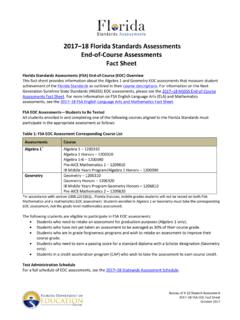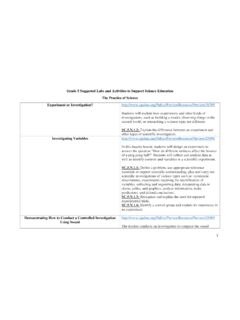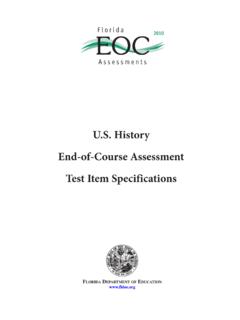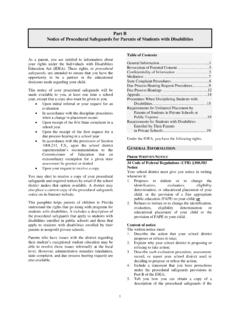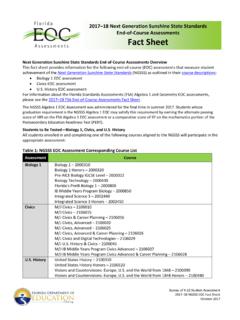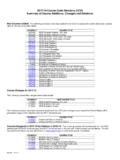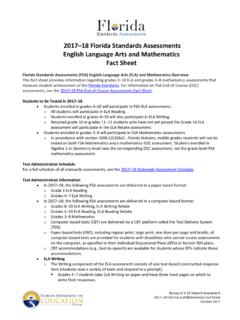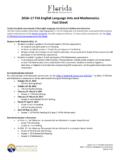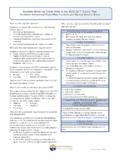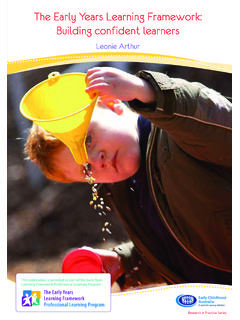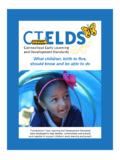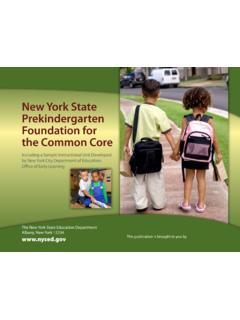Transcription of Prekindergarten Children with Disabilities
1 Prekindergarten Children with Disabilities Expanding Opportunities for Providing Services A GUIDE FOR MAKING SYSTEM AND PROGRAM LEVEL DECISIONS 2008 Florida Department of Education Bureau of Exceptional Education and Student Services Technical Assistance and Training System Project This publication is one of many publications available through the Bureau of Exceptional Education and Student Services, Florida Department of Education, designed to assist school districts, state agencies that support educational programs, and parents in the provision of special programs. For additional information on this publication, or for a list of available publications, contact the Clearinghouse Information Center, Bureau of Exceptional Education and Student Services, Florida Department of Education, Room 628, Turlington Building, Tallahassee, Florida, 32399-0400.
2 Telephone: (850) 245-0475 Fax: (850) 245-0987 SunCom: 205-0477 E-mail: Web site: Prekindergarten Children with Disabilities Expanding Opportunities for Providing Services A Guide for Making System and Program Level Decisions 2008 Development of the Prekindergarten Children with Disabilities Expanding Opportunities for Providing Services: A Guide for Making System and Program Level Decisions, was supported by the Inclusion Workgroup of the Technical Assistance and Training System (TATS) project. The Technical Assistance and Training System project is funded by the State of Florida, Department of Education, Bureau of Exceptional Education and Student Services (BEESS), through federal assistance under the Individuals with Disabilities Education Act (IDEA), Part B. Copyright State of Florida Department of State 2008 Authorization for reproduction is hereby granted to the State System of Public Education consistent with Section (2), Florida Statutes.
3 No authorization is granted for distribution or reproduction outside the State System of public Education without prior approval in writing. Prekindergarten Children with Disabilities Expanding Opportunities for Providing Services A Guide for Making System and Program Level Decisions 2008 Bureau of Exceptional Education and Student Services Florida Department of Education Technical Assistance and Training System Project Table of Contents v 1 What Does the Research Show? .. 3 Educational Outcomes for 3 Social Relationships and Patterns of Interaction .. 3 Family Perspectives and Community Inclusion .. 4 System Level 5 Program Level Considerations: Decision-Making 7 Appendix A School District Gathering: Community Baseline Information for Preschool-Age 11 Appendix B System Level Guiding Questions .. 13 Appendix C Program Level Guiding Questions.
4 15 Appendix D Potential Partners for 17 Appendix E Program Models for 19 Appendix F early childhood Program Partner Questionnaire .. 21 Appendix G Strategic Plan of Action .. 23 Appendix H Training and Technical Assistance 25 Appendix I 29 iii Preface The purpose of this system guide is to assist school districts in making decisions about inclusive early childhood placements for Prekindergarten Children with Disabilities . This guide addresses system and program decisions that need to be made and is intended for use by district-level administrators and Individual Educational Plan (IEP) teams, including families. It outlines the critical steps to be considered when determining the most appropriate service provision for preschool Children with Disabilities . Acknowledgements We gratefully acknowledge the following individuals for their contributions to this effort: Susan Benner TATS Project Coordinator Dana Bennett TATS-FGCU Regional Facilitator Anne Cahn Office of early Learning, AWI early Learning Program Manager Susan Donovan TATS Project Coordinator Bonnie Duncan Seminole County School District Teacher Beverly Esposito Florida Children s Forum VP, Professional Development Kim Galant TATS-FSU Regional Facilitator Nancy Haynes Citrus County School District Pre-K ESE Program Specialist Paula Kendig TATS-UWF Regional Facilitator Cheryl Liles Florida Inclusion Network Director Lou Ann Long Central Directory Director Amanda Moore Office of early Learning, AWI CCR&R Inclusion Coordinator Mona Schuster Pinellas County School Board Child Development Specialist Sarah Sprinkle Orlando YMCA Vice President, Child Development Patricia Stickford Volusia County School District Pre-K ESE Program Specialist v Introduction Since 1975.
5 Federal law has required that Children with Disabilities have access to a free appropriate public education (FAPE) in the least restrictive environment (LRE). The newly reauthorized Individuals with Disabilities Education Improvement Act (IDEA 2004) continues to require school districts (also known as local education agencies, or LEAs) to provide FAPE and LRE to Children with Disabilities . The IDEA requires each state to develop a State Performance Plan (SPP) that includes measurable and rigorous targets to improve special education services. States use the targets in the SPP to analyze the performance of each LEA in the state and report annually to the public on performance. The targets are aligned with indicators within the plan. Indicator 6 of the SPP addresses educational settings for preschool Children identified as having Disabilities . Districts have collected data during 2004 through 2005 and reported the percentage of time Children spend with peers who are not disabled.
6 Goals have been set to increase this percentage over time. This document can be used as a resource for districts to achieve those goals. Florida Statute ( ) offers language parallel to that in IDEA. This language states: Segregation of exceptional students shall occur only if the nature or severity of the exceptionality is such that education in regular classes with the use of supplementary aids and services cannot be achieved satisfactorily. (Section (6), ) The emphasis on participation in the general education curriculum is intended to ensure that accommodations or modifications are made to enable Children with Disabilities to interact with their typically developing peers. This initiative can mean a broader continuum of services for young Children with special needs as they are offered the opportunity to participate in the general education curricula and, whenever possible, in a regular classroom.
7 Requirements for LRE and the accompanying decision-making process to accomplish this also apply when considering service provisions for Prekindergarten Children with Disabilities . In the K through 12 public school system, classrooms for regular education students may be used as a service provision option for LRE. However, not all school districts operate preschool programs for typically developing young Children nor is this a requirement imposed by IDEA. This situation poses a challenge to finding a practical solution to ensuring LRE for this population. For this reason, agencies that serve preschool Children with Disabilities should take into consideration other early childhood settings as options to increase opportunities for interaction with typically developing peers. Other early childhood settings may include Head Start, early Head Start, Title I preschool classes, the Voluntary Prekindergarten Education Program, school readiness, and private preschools.
8 Consideration of these options may broaden the scope of service delivery to include other early childhood programs in the school district and the community. When the individual educational plan (IEP) team determines that service provision with typically developing peers is needed to provide a free appropriate public education in the least restrictive environment, efforts should be made to locate appropriate early childhood settings where the child s IEP can be implemented with supplementary aids and services, when necessary. 1 The purpose of this guide is to facilitate school district personnel and families working as a team in the decision-making process to identify potential early childhood settings within their district and community in which Children with Disabilities can receive services with their typically developing peers. The guide consists of systemic and program considerations (settings, data gathering, partners, models of inclusion, training and technical assistance, and plan of action) that impact the LRE initiative.
9 Supporting documents include a questionnaire for early childhood program partners and a listing of potential preschool partners and models. This guide can also assist districts with planning for systemic evaluation and collaboration with community-based programs. 2 What Does the Research Show? The following review of the literature looks at the benefits of inclusive settings with regard to educational outcomes, building social relationships, and family perspectives. Educational Outcomes for Children Since at least 1980, research on the outcomes of preschool inclusion has been conducted with the results of this research indicating that Children with Disabilities enrolled in inclusive settings make at least as much progress on standardized measures of cognitive, language, motor, and social development as Children in non- inclusive preschool special education classrooms (Odom , 2004). In addition, across the range of Disabilities there is evidence of positive outcomes for Children with Disabilities .
10 Roper and Dunst (2003) suggest that a variety of opportunities, as well as the frequency of the opportunities provided to the child with a disability, will promote and sustain language and social competence. Children with Disabilities made significant gains in both the area of language development and classification/communication skills when instruction was delivered in an inclusive setting (Klein, Geiss, Kushner, & Hill, 2003). Children with and without Disabilities learn from each other in inclusive settings (Committee on Integrating the Science of early childhood Development, 2000). Positive outcomes accrue for typically developing Children who are enrolled in inclusive settings. These outcomes are related to developing a greater understanding of Disabilities and an increased sensitivity to individual differences (Odom et al., 2004). There are two factors that appear to influence the performance on standardized developmental measures of Children with and without Disabilities in inclusive settings.
